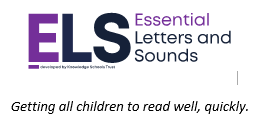Phonics
We follow a DfE validated systematic synthetic phonics (SSP) programme called Essential Letters and Sounds (ELS).

What is phonics?
Synthetic phonics is a way of teaching children to read. It teaches children how sounds are represented by written letters. Children are taught to read words by blending these sounds together to make words. For example, they will be taught that the letters ‘m-a-t’ blend together to make ‘mat’.
A synthetic phonics programme, such as ELS, provides a structure for teaching these sounds in a certain order to build up children’s learning gradually. It is used daily during Reception and Year 1 to teach all the sounds in the English language.
How is ELS taught in school?
With ELS, there is a daily phonics lesson where children are taught a new sound, or where they review sounds learnt earlier in the week. This is shown to the class on the whiteboard.
Children learn the letters that represent the sounds. They are then asked to read words and sentences with the new sounds in them. Children will also practise writing the letters that represent the sounds.
Additional support
ELS is delivered using a whole-class approach. This ensures that all children benefit from the full curriculum. Children who encounter difficulties are supported by the teacher throughout the lesson, and where further support is required, ELS has three interventions to ensure that any learning gaps are quickly filled. These are intended to be short and concise. This helps ensure that children do not spend excessive time outside of the classroom or in group intervention sessions where they are removed from the rest of the curriculum.
Assessment
It is important that children’s progress is assessed thoroughly, so that any gaps can quickly be identified.
Assessment of the children’s reading skills is key to ensuring that all children make rapid progress through the programme, and that they keep up rather than catch up.
We assess children’s phonic knowledge in the fifth week of each half-term, to allow all members of staff to target and close any gaps that may be present in either sound knowledge or reading skills. By undertaking assessment in the fifth week, we are able to action a direct intervention before any upcoming school holidays.
Decodable readers
It is vital that whilst children are learning to read, they read books that match their phonic knowledge. The Oxford University Press decodable readers support Essential Letters and Sounds and have been carefully matched to every aspect of the programme. We use these books in school and as take-home readers.
How can I help at home?
Practising the sounds
You can help your child practise the sounds they have been learning at school. Download the charts from the Oxford Owl for Home website so you can see the list of sounds in the order they’ll be taught: Essential letters and sounds - Oxford Owl You can show these to your child along with the picture to help them remember.
Learn how to pronounce the sounds correctly.
Reading decodable books
Your child will bring home reading books with words that use the sounds they have been learning in school. You may hear these reading books called ‘decodable books’. Use the prompts inside the front and back covers to enjoy the book together and help your child practise reading.
By reading and re-reading texts both in school and at home, we offer children the opportunity to develop a cohesive orthographic map of the words within our language. This in turn helps to build their reading fluency. The more you can read at home with your child, the better. We ask that children read the decodable reader they bring home at least three times during the week.
You can find more information about ELS, including the order the sounds are taught in, on the Oxford Owl website: Essential Letters and Sounds - Oxford Owl

